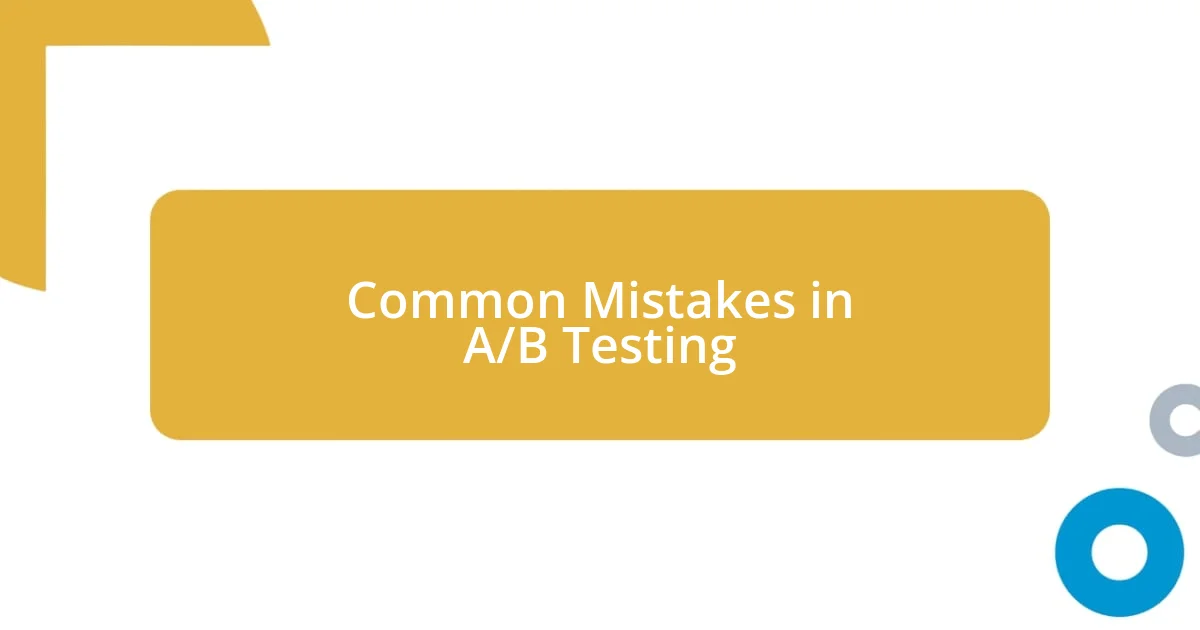Key takeaways:
- A/B testing empowers data-driven decision-making by allowing the comparison of different versions of marketing assets to identify what resonates with audiences.
- Key metrics like conversion rate, click-through rate, and bounce rate are crucial for measuring the effectiveness of A/B tests and ensuring statistically significant results.
- Ongoing A/B testing fosters a culture of curiosity and continuous improvement, revealing insights that enhance user engagement and inform future strategies.

Understanding A/B Testing Basics
A/B testing is a powerful tool that allows you to compare two versions of a webpage, email, or any other marketing asset to determine which one performs better. I remember the first time I conducted an A/B test on a landing page; it was thrilling to see how a simple change in the call-to-action could lead to significantly higher conversion rates. Have you ever wondered how small tweaks can yield such impactful results?
In essence, A/B testing splits your audience randomly, exposing each group to a different version. I once ran a test on two subject lines for an email campaign, and the one with just a bit of personalization made a world of difference in open rates. It really hit home for me how understanding human behavior can drive more effective strategies, don’t you think?
The goal here is to make data-driven decisions instead of relying on gut feelings. I often find myself reflecting on the importance of stepping back and letting the numbers speak for themselves. It’s fascinating how, in a fast-paced environment, taking the time to validate your assumptions through testing can lead to insights you might never have considered otherwise. What stories could your data tell if you gave it a chance?

Key Metrics for A/B Testing
When diving into A/B testing, understanding key metrics is essential for measuring success. From my experience, metrics like conversion rate, click-through rate (CTR), and bounce rate tell a compelling story about user interaction. I recall a specific test where I altered the color of a button; I was delighted to see how a minor change significantly boosted the click-through rate.
Here are the primary metrics I focus on in A/B testing:
- Conversion Rate: The percentage of users completing a desired action, like making a purchase or signing up for a newsletter.
- Click-Through Rate (CTR): The ratio of users who click on a specific link to the number of total users who view a page, helping gauge interest.
- Bounce Rate: The percentage of visitors who leave after viewing only one page, indicating the effectiveness of your content in retaining interest.
I have also learned the importance of statistical significance. It’s all about determining whether the results are genuine or just a result of chance. I remember feeling a mix of excitement and nervous anticipation as I watched the data come in, hoping for clarity in the numbers. Each metric offers a lens through which to view user behavior, reinforcing the idea that informed decisions can truly transform your strategy.

Designing Effective A/B Tests
Designing effective A/B tests requires a thoughtful approach when it comes to variables and target audience. I vividly recall a time when I tested two different headlines for a blog post. It was impressive to see how a simple tweak transformed not only the engagement but also the feedback from readers. Foundationally, I believe each element, from color to wording, matters; every detail can create a ripple effect in user behavior.
Equally important is ensuring that your sample size is adequate. I once neglected this aspect, launching a test with only a handful of visitors, and naturally, the results were inconclusive. I learned that larger audiences provide more reliable data. It’s like standing in a crowded room; the louder the voices, the clearer the message. The more participants you include, the better your chances of getting statistically sound results.
You also want to establish clear objectives before diving into the test. I remember a project where I simply wanted to increase newsletter sign-ups, yet I had multiple changes happening simultaneously. It became unclear which modification had the most impact. Focusing on one change at a time helps clarify the results, ensuring that the insights are actionable moving forward.
| Factor | Importance |
|---|---|
| Variable Control | Maintains focus on one element at a time, making the results clear. |
| Sample Size | Ensures statistical significance, leading to reliable insights. |
| Clear Objectives | Guides the testing process, keeping efforts aligned with specific goals. |

Common Mistakes in A/B Testing
One common mistake I often see in A/B testing is neglecting to phase out test variants too soon. In my early tests, I would jump to conclusions before the data had matured, perhaps because I felt eager to showcase results. Looking back, I realized it led me to make decisions based on fleeting trends rather than solid evidence. Could you imagine investing time into a strategy only to find it was just a momentary spike?
Another pitfall is failing to account for external variables that can impact the results. I remember a specific test where I adjusted the call-to-action button on my website, but I forgot about an ongoing marketing campaign. As a result, traffic spiked and skewed my data. How can you trust the numbers when outside influences are at play? It’s crucial to isolate your tests or document everything that’s happening concurrently to ensure you get an accurate picture.
Finally, many get lost in the temptation to test too many variables at once. I once changed the layout, content, and color scheme all in one go. The end result was chaos—how could I determine which change led to meaningful improvement? I learned that it’s not just about gathering data; it’s about ensuring that the insights gained are actionable. Focusing on one key change really allows you to hone in on what matters, and trust me, that clarity makes all the difference.

Analyzing A/B Test Results
When I first started analyzing A/B test results, I remember feeling overwhelmed by the numbers. It was like staring at a wall of data that seemed to blur into one another. I had to remind myself to focus on the bigger picture—what the results meant for my goals. I found that breaking down the data into key metrics, such as conversion rates or user engagement levels, really helped in distilling the essence of what happened during the test. Isn’t it fascinating how a few key statistics can reveal such deep insights into user behavior?
One particular test stands out in my memory. I analyzed the impact of a new landing page design and was initially buoyed by an upward trend in sign-ups. However, I dug a little deeper and realized that the increase was only significant during peak hours. This anomaly taught me the value of understanding user behavior over time, not just at face value. Have you ever had that moment when data tells a different story than you expected? It’s such a humbling experience, and it highlights the need for patience in analysis.
While reviewing a split test results report, I learned about the importance of setting benchmarks. I used to compare new results against vague notions of “better” without considering historical data. This became a barrier that often led to misguided conclusions. By establishing concrete performance metrics prior to the test, I found that I could evaluate whether a result was genuinely an improvement or just noise. It’s about creating a roadmap for understanding the journey your users take; otherwise, how can you know if you’re heading in the right direction?

Implementing Learnings from A/B Tests
When it comes to implementing learnings from A/B tests, I can’t stress enough the importance of documenting every insight gained. I’ve made the mistake of letting valuable findings fade into oblivion because I didn’t prioritize note-taking. After one particularly enlightening test, where a simple headline change produced a staggering conversion boost, I vowed never to let those insights slip away again. By keeping thorough records, I find it easier to refer back to successful strategies when crafting new campaigns.
Moreover, I’ve discovered that the best way to implement findings is to prioritize them based on potential impact and feasibility. For example, after an A/B test revealed that users preferred a more personalized experience, I didn’t just rush into an overhaul of my entire platform. Instead, I made incremental changes, like adding user names to emails and adjusting product recommendations. Doesn’t it feel more manageable to take small steps rather than diving into a complete transformation?
Another key aspect of implementation is sharing the learnings with your broader team. I remember a time when I sat down with my colleagues to discuss the results of a test that significantly improved our email click-through rates. The energy in the room was electric as we brainstormed how to replicate this success across other channels. Engaging others not only amplifies the insights but also fosters a culture of continuous improvement. Who wouldn’t want to be part of a team where sharing knowledge leads to greater overall success?

Continuous Improvement through A/B Testing
By constantly running A/B tests, I’ve come to see it as an ongoing journey of improvement rather than a one-time event. Each test feels like a stepping stone; even small tweaks can lead to unexpected breakthroughs. I remember tweaking the color of a call-to-action button; it seemed trivial at first, but the results blew me away. The simple act of testing allowed me to uncover what truly resonates with my audience. Isn’t it amazing how a minor adjustment can lead to significant shifts in user behavior?
Another experience that sticks with me is how A/B testing fosters a mindset of curiosity. I often find myself asking, “What if?” This question pushes me to explore various possibilities, leading to a culture of experimentation. For instance, when I tested different email subjects, some performed beyond my wildest dreams while others flopped. Embracing these outcomes—whether successes or failures—has taught me that every result is an opportunity for learning. Have you ever had a hypothesis that didn’t quite hold up? It’s in those moments that we learn the most about our users and ourselves.
The beauty of A/B testing lies in its iterative nature; it encourages me to refine strategies continuously. After a series of tests, I learned that my audience responded better to video content than long-form articles. So, I shifted my focus and began creating more engaging visual materials. This wasn’t just a win for my metrics; it felt rewarding to create content that truly resonated with people. When have you felt that thrill of aligning your efforts with what your audience genuinely wants? Continuous improvement through A/B testing isn’t just about the numbers, it’s about connecting with users on a deeper level.














